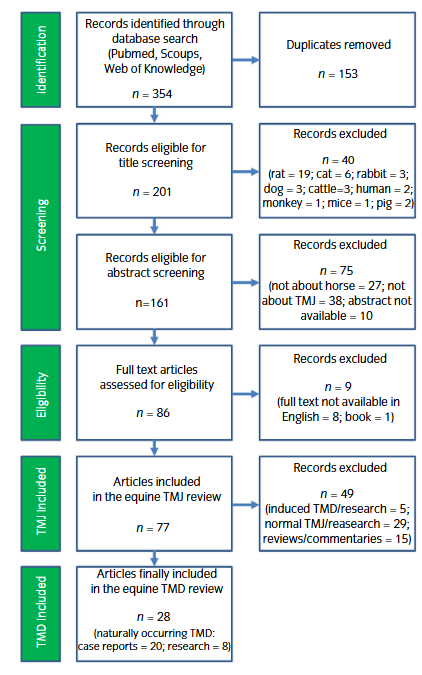- Veterinary View Box
- Posts
- TMJ in horses-what do they get?
TMJ in horses-what do they get?
Equine Vet J. 2025
Tomasz Jasiński, Bernard Turek, Michał Kaczorowski, Walter Brehm, Katarzyna Skierbiszewska, Małgorzata Domino
Background
The temporomandibular joint (TMJ) in horses facilitates mandibular movement and mastication. Temporomandibular diseases (TMDs) can impair joint function, leading to clinical signs such as pain, swelling, and difficulty chewing. Despite increasing interest in equine TMJ dysfunction, diagnostic approaches vary. This study aimed to systematically review clinical data on equine TMD, assessing its causes, clinical signs, and diagnostic approaches.
Methods
Systematic Review Design:
-Literature search conducted in PUBMED, Scopus, and Web of Knowledge following PRISMA 2020 guidelines.
-Case reports and research articles on equine TMD were included.
-Studies categorized into septic TMJ arthritis, primary TMJ osteoarthritis (OA), and non-arthritic TMDs.
-Risk of bias assessment performed using the ROBINS-I tool for non-randomized studies.
Results
51 publications met inclusion criteria.
TMD Prevalence:
-Septic TMJ arthritis (41.2%) was the most common cause, followed by fractures/luxations (29.4%) and primary TMJ OA (21.6%).
-Trauma was confirmed or suspected in 54.9% of cases.
Clinical Signs:
-Primary TMJ OA cases had mild to moderate symptoms, including jaw stiffness, aversion to bit pressure, and difficulty chewing.
-Septic arthritis and fractures showed moderate to severe clinical signs, such as severe pain, swelling, and jaw dysfunction.
Diagnostic Imaging:
-CT was used in 92.2% of cases, highlighting its role as the gold standard.
-Radiography (84.4%) was frequently performed in field settings.
-Ultrasonography (21.6%) had limited use.
Laboratory Testing:
-Bacterial culture was recommended for septic arthritis cases.
-Functional tests and local analgesia were suggested for diagnosing primary TMJ OA.
Limitations
Inconsistent clinical data across studies.
Potential risk of bias due to missing or incomplete reports.
Heterogeneity in diagnostic protocols, preventing a meta-analysis.
Conclusions
Equine TMDs are underreported and frequently linked to trauma. Regardless of etiology, TMDs can lead to significant TMJ dysfunction, affecting mastication and performance. CT should be prioritized for accurate diagnosis, while radiography remains a practical field tool. For septic TMJ arthritis, bacterial culture is essential, whereas functional testing and local analgesia are crucial for diagnosing primary TMJ OA. Future research should focus on standardizing diagnostic criteria and treatment strategies for equine TMJ disorders.

PRISMA flow diagram depicting studies included andexcluded from the review.4 JASIŃSKI ET AL .
How did we do? |
Disclaimer: The summary generated in this email was created by an AI large language model. Therefore errors may occur. Reading the article is the best way to understand the scholarly work. The figure presented here remains the property of the publisher or author and subject to the applicable copyright agreement. It is reproduced here as an educational work. If you have any questions or concerns about the work presented here, reply to this email.